HOPE not hate uses cookies to collect information and give you a more personalised experience on our site. You can find more information in our privacy policy. To agree to this, please click accept.
The far right in recent Irish history has had little success in either street or electoral mobilization, write Thom Barry and Matthew Collins. How big is the risk that will change?
Not since the 1930’s has Ireland experienced a large fascist movement. Amidst ongoing rancour between pro-treaty and anti-treaty former IRA men, The Army Comrades Association formed. Later christened the ‘Blueshirts’ they were led by former Garda (police) commissioner Eoin O’Duffy who had been a close ally of former IRA leader Michael Collins.
Duffy and his followers believed Ireland was close to falling under Communist control in the guise of the remains of the IRA which had shifted to the left after the Irish Civil War. Sinn Fein had also split into many different parties and factions. Duffy sided with a faction that would later become Fine Gael.
Duffy was a curious if not avowed admirer of European fascism. He also believed and expanded the notion of a superior Irish race – the Gaels. Like with his disastrous intervention in the Spanish Civil War, he tied the Irish, the Gaels, to Catholicism, blood and soil.
Unlike Collins, O’Duffy was to witness the rise of fascism in Europe and became convinced that fascism was the perfect bulwark to European Communism. Duffy’s urgency was hurried by Adolf Hitler’s rise to power in Germany and the crushing of antifascist and Communist resistance.
It is estimated the Blueshirts had some 30,000 members at its peak, rallying around Ireland in violent clashes with Republicans and Irish Communists. The Irish government held grave fears the Blueshirts would either lead a military coup or worse still, reignite an Irish civil war.
As Duffy courted international support, he met with British fascist leader Oswald Moseley, who it is believed offered O’Duffy a united Ireland if he, Moseley, took power in Britain as he expected himself to.
O’Duffy and the Blueshirts came to an abrupt decline after their disastrous intervention in the Spanish Civil War. They returned home sunburnt, disgraced and ridiculed. By the start of the Second World War, Ireland had completely rejected notions of fascism and Duffy and a few followers retreated to the bottle and in shame.
Much of this article will focus on the current attempts by far right actors to bring into existence far-right street and political movements in the Irish Republic.
Their numbers are increasing and their use and abuse on social and alternative media is spreading. Over the past three to four years there has been attempts made by both old and familiar faces as well as a new generation of vloggers and obscene social media players to replicate the British counter-Jihad and the subsequent ‘Yellow Vest’ and ‘DIY’ movements.
Although their ‘noise’ is getting heard, these actors have as yet, been spectacularly unsuccessful politically. However, with Dublin experiencing a crippling housing crisis and a reversal of the previous large numbers of people that used to leave the country, Ireland is now experiencing an upsurge in both immigration and far right activity.
What masks and covers a lurch by some into the far right is the growth of conspiracy theory and a pushback against growing secularism.
The historical failure of the far right in Ireland needs some caveats first. As HOPE not hate readers are aware, consistent links between British far right groups like Combat 18 and the National Front have existed with some elements within Loyalism in the north of the country [Northern Ireland]. These links were often encouraged because the British security services had heavily infiltrated and afforded assistance to some of those terror groups and used links with the British far right to gather further intelligence and influence.
Alongside the historical suspicions and hatreds of Loyalism, the overwhelming opinion within the Irish Republic is that Northern Ireland as set up in 1921, was racist and anti-Irish. Inasmuch, most Irish nationalist movements have embraced progressive, internationalist and anti-Imperialist politics. Certainly, during the ‘troubles’, the ideas of national unity and the origins of conflict from 1968 are seen as rooted in the structural sectarianism of the northern state itself. Perhaps more salient is what arises today from our understanding of what happened during the conflict before the Good Friday Agreement (GFA) of 1998.
Researchers and campaigners such as Anne Cadwallader and the Pat Finucane Center, find and portray the strategies adopted at that time by the British Army as best understood as explicitly far right and ethno-nationalist. The strategies employed in Northern Ireland were first developed as ‘counter-insurgency’ by General Frank Kitson following colonial misadventures with the British Army through Malaya, Kenya, Adin and Cyprus in the 1950’s and 60’s.
Kitson’s counter-insurgency plan was born in colonialism with a racist determination to exterminate where they could not dominate. The strategy was also employed in Northern Ireland by the use of pseudo gangs and clandestine paramilitaries used to bomb, shoot and kill. Collusion between the British state and Loyalists paramilitaries focused almost entirely on Catholics with no links to republican groups- right up until the ceasefires which began in 1994. It would be remiss of an article looking at the far right in Ireland to not highlight that the British state itself has, in living memory of most the north of Ireland, facilitated and orchestrated the far-right murder of innocents whilst never having to admit its role. That long and open sore – that an imperialist power carried out and gave assistance to murder gangs – has laid a difficult path for those that would seek to proffer and encourage similar thoughts and actions within the Irish Republic.
So what about south of the border?

A Catholic backdrop
Far right activism in the south of Ireland overlaps with fundamentalist Catholicism in almost every breath. There is no room for secularism, even if their behavior and opinions would appear to be most unchristian. While Irish society and communities are still dominated by the logic of neoliberal inequality, the theocratic state has been broken. Within three decades – and as a result of tireless work of campaigning, grassroots organising and mobilisations – two interrelated phenomena converged.
The first was the making visible of the nature, scope and scale of state/church abuses, particularly in working class urban and rural populations that occurred for the best part of half a century. The Catholic Church saw a wave of state-sanctioned investigations, which, though restricted in reference and recommendations, still provided a damning picture of an almost institutional sadism. It is hard to exaggerate the extent to which the Catholic Church has lost grip on its previous unquestionable social, political power and legitimacy. This collapse provoked a response from the right-wing of the Catholic Church in Ireland at the end of the 20th century that continues to reverberate. Clergy shaped by small traditions in the catholic church of liberation theology, Marxist ideas and practice were either emigrated or sent elsewhere to avoid the further growth of any egalitarian theology or ministry.
In 2019, many of the names and faces of the far-right micro groupings came to adulthood as fervent believers of an authoritarian faith wedded to the idea of a corporate, rural, fascist state. There exists in new groups made up almost exclusively of young men who knew nothing of it, a desire to return Ireland to a period where sexuality, divorce and reproductive and democratic rights and all question of morality are governed by clerics.
Although tiny, fascist groups have long existed in Ireland. They tended to be geographically bounded, rarely extending beyond discussions and minor disruptions and rarely venturing beyond the towns or cities they existed. This quarantine of their ideas and activities was governed throughout the 1980’s and 1990’s in particular by a militant Irish left which encompassed Irish nationalism and Republicanism with a militant internationalist and antifascist mentality. This militancy and the use of anti-fascist tactics was successful in disrupting attempts at larger coordination into the mid-2010s.
The second phenomena to rally the far right are two referendum results to hit right at the heart of their blood, soil and church. The same-sex marriage referendum in May 2015 and another on abortion rights in 2018, provided distinct rallying points for the right to try firstly to galvanize a groundswell and secondly, expand a hard-core fundamentalist base. In both referenda the right’s anti-proposition campaigns came to no fruition, but what could be seen as massive progressive shifts in Ireland’s attitudes did have the effect of bringing disparate far right groupings into contact with each other online. Since the 2018 abortion rights campaign, the increase in noise and bluster that links both the legalization of gay marriage in 2015 and a woman’s right to an abortion in 2018 with increased conspiracy and anti-immigrant rhetoric. The use of social media afforded right-wing conservatism a new voice, creating an emerging narrative around several recognisable themes.
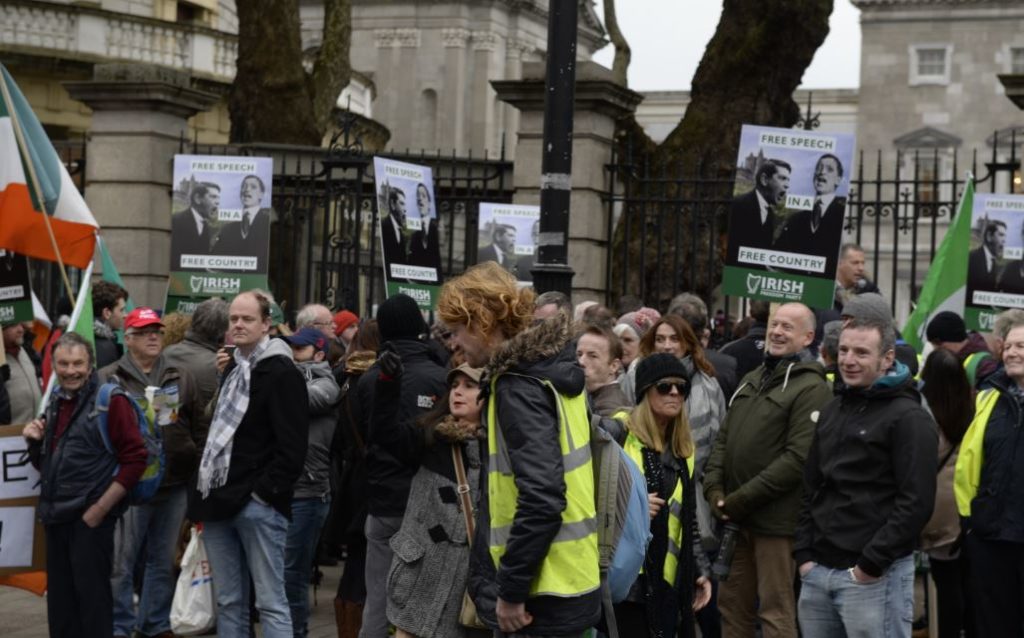
The Far Right Observatory, an adhoc group set up in Nov 2019 to monitor emerging far right activity identified these several meta narratives:
Traitorous elite versus the pure people: A narrative widely used also in the UK, whereby the general population is framed as ‘stupid’ and ‘oblivious’ to reality and specific target groups are portrayed as ‘traitors’ and ‘deviants’. Those extolling these messages position themselves as ‘truth’ holders.
Globalism: With growing hints of traditional Antisemitism, Ireland on a global stage is at the mercy of ‘globalists’ hell-bent on imposing immigration and abortion in a push to impose a ‘new world order’. These are the traits of a modern country at the mercy of a hidden agenda, a ‘new world order’ and normally as in other countries, portrayed as the doings and the work of individuals like George Soros. These conspiracies are also part of the wider conspiracy of ‘Cultural Marxism’.
The idea and use of Irish cultural purity and nativism is prominent in part of the narrative that although there are Globalists seeking to destroy a unique Irish culture and ‘native Irishness’, that a reembracing of Church and romantic and nostalgic ideas of Ireland can countenance a perceived degeneracy sweeping Ireland.
Much of the language and conspiracy theory mimics the conspiracy theories parroted by the British far right. Indeed both Jim Dowson and Jack Sen have made political forays into the Irish Republic in the last eighteen months. Although the Irish far-right as yet lacks the degeneracy of the British far right, for the moment, it also lacks some of the sophistication and tech know-how that often helps exaggerate influence.
The Irish far right’s self-portrayal that they are being silenced from bringing the truth to Ireland about immigration, 5G, global warming and even chemtrails now plays on the stock-standard belief that this is the world of increasing Jewish influence in the country.
Social media companies have now begun deplatforming some of the worst offenders who spread fear and hatred and as a result, there are relatively smaller groups of Irish fascists professing militancy moving to unmonitored platforms like Telegram. Inside those Telegram groups so far, is little more than an obsession with hiking and conspiracy.
Militant antifascism is very much still the response to fascism in Ireland and clashes between fascists and antifascists, although rare, do occur.
‘Free Speech’ protests about a myriad of confusing issues are increasing and so too are their numbers.
The initial test as to how a small movement of still disparate actors’ can translate into votes at the ballot box will be seen early next year when the Irish go to the polls in the first quarter of 2020. How bizarre it would be that after years of resistance, we finally succumbed to what we thought was a thoroughly English disease.
So who are the actors?
The National Party
The imaginatively titled National Party is an entho-nationalist party set up by Justin Barret in 2016. 48-year old Barrett has long been a high profile figure in the Republic, making his name during the 1980’s as a member of the violent ‘pro-life’ group ‘Youth Defence.’
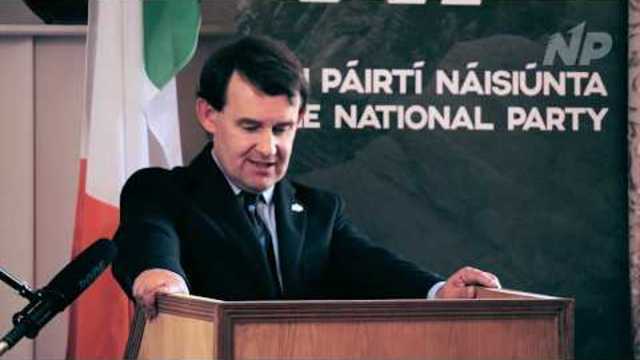
Barrett has spent a substantial amount of time travelling Europe, meeting other far right extremists including the neo-Nazi NPD in Germany and the ultra-catholic fascists of Roberto Fiore’s Furzo Nouva in Italy.
It comes as little surprise, then, that NP is not too dissimilar to parties of old in the UK like the National Front and British National Party.
The Deputy leader of NP is James Reynolds, the former Chair of the Longford branch of the Irish Farmers’ Association.
Barrett tried to hold a public launch of the party in Dublin in November 2016, confident that the conditions were right for the far right to show its face in the Irish capital unmolested. He was very, very wrong. The party has a small office in Longford, away from the Irish capital. Barrett has declared NP a party for “straight, white people.”
Before the NP was established, Barrett ran for election as an MEP in 2004 picking up just 2% of the vote. Campaigned consistently against abortion rights and fought against the introduction of divorce in 1995. He later changed his opinion after his wife left him. Barrett has also called for doctors carrying out pregnancy terminations to be “executed.”
Membership is thought to be just a couple of hundred strong. The party also calls for the deportation of foreigners and for a United Ireland.
Identity Ireland
Peter O’Loughlin tried to launch his party in Dublin on the fourth anniversary of Andres Brievik murder spree in Norway. of young leftists in Norway.
Despite persistent troubles, English Defence League founder Stephen Lennon visited O’Loughlin in January 2016 to help promote Pegida Ireland. At a press launch in Cork a number of threats were made to a television documentary maker. Plans to hold a rally in Dublin a week later led to a militant intervention by antifascists.
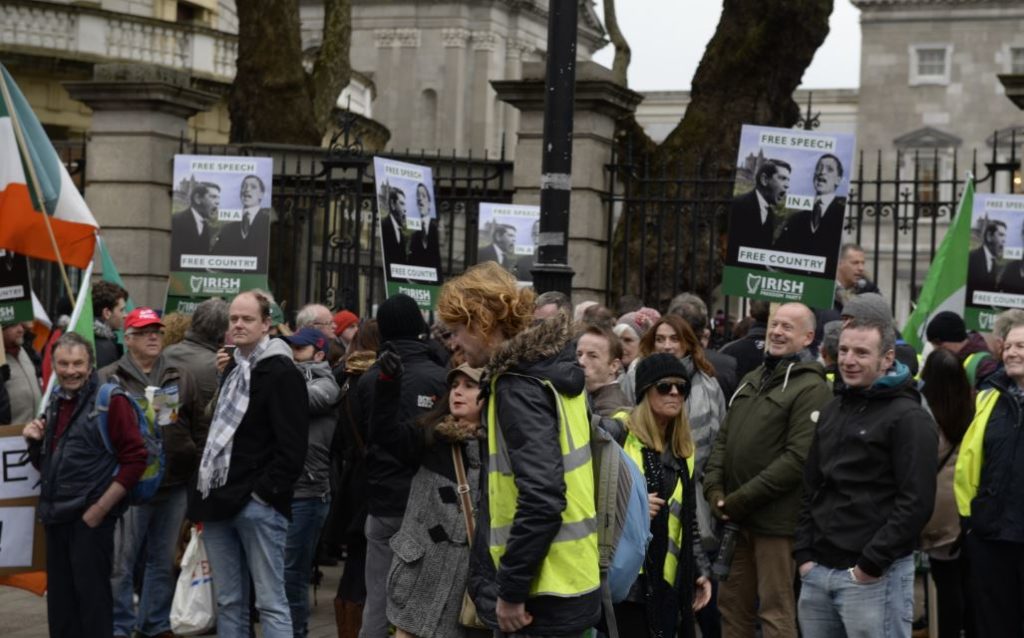
Identity Ireland received 183 votes in the 2016 election which was 0.01% of the vote. O’Loughlin ran in the 2019 European elections picking up 3,600 votes, approximately 0.2% of the vote.
The Irexit Party/Irish Freedom Party
The Irexit Freedom Party was launched in the luxurious Royal Dublin Society in Dublin in February 2018. Billed as a parallel movement starter to the Brexit movement in the UK. Rather disparagingly it was counter-billed as a party for ‘West Brits’ a term often used to describe people that hark back in favour of British rule.
The star attraction at the launch was Nigel Farage MEP who currently leads the Brexit Party in Britain. The head of The Irexit Freedom Party is Hermann Kelly. Kelly presents himself as an Irish ultra-nationalist and friend of the Irish working class. His day job is as spokesman for the Farage led Europe of Freedom and Direct Democracy.
Antifacists discovered very quickly that the party’s twitter account, facebook and website were run by the UK-based Bangladeshi Jew hater and close friend of former BNP leader Nick Griffin, Jack Sen. Sen had been hiding in rural Ireland after his own fascist group in the UK collapsed.
To date, The Irexit Party has only demonstrated how little support it has. Its last mobilsation was a welcoming demo for the homophobic US vice president Mike Pence in September this year. A total of three people attended.
Gemma O’Doherty
Gemma O’Doherty is a former high profile journalist and failed Irish presidential candidate. After failing to secure enough nominations to stand for President in 2018 O’Doherty, a high profile champion of exposing corruption appeared to lose faith in many things- most of all reality. Her group, ‘Anti Corruption Ireland’ peddles horrific conspiracy theories and earlier this year found themselves deplatformed because of this. Since this, O’Doherty has portrayed Ireland as a fallen victim to godlessness and political correctness. In particular, O’Doherty focusses on Islam and other “hidden forces” being at work- even Dublin airport of all places.
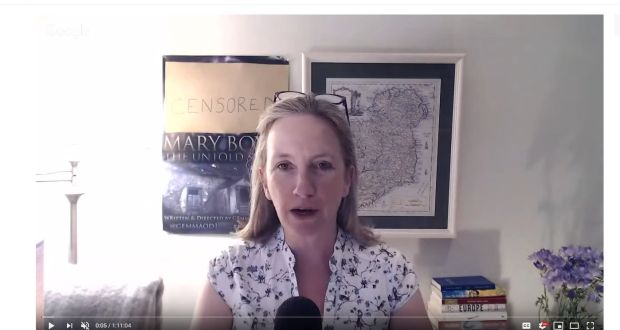
Having spent years as a journalist focusing on police and state corruption, she was seen by many to be tenacious and plucky. She masked her apparent fundamentalism from public view until recently. After her failure to secure nominations for the Irish Presidential Election, she claimed a “political elite” had blocked her path. O’Doherty stood in the 2019 European Election as an independent and not under the banner of her political group “Anti-Corruption Ireland” which she formed in February 2019. She hit the headlines properly a month later when after small column inches about detrimental views on things like vaccines and gay rights, she described the Christchurch terror attack on a Mosque as a “false flag” operation. Despite a significant election campaign which saw her image and slogans temporarily carried on the sides of Dublin busses (“it’s time to take Ireland back”), she polled a poor 1.8%, coming ninth.
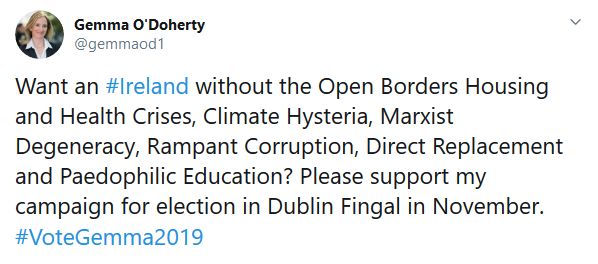
O’Doherty and not an insignificant number of her followers can often be seen picketing the offices of Google in Dublin. Having been deplatformed by a number of social media companies, she believes there is a significant conspiracy afoot to silence her and her many “truths.” That such a formerly high profile and significant public figure has moved into such quarters has helped raise the profile of conspiracy theory across Ireland. Many find it impossible that such an entrenched force previously for good, could simply turn so sharply.
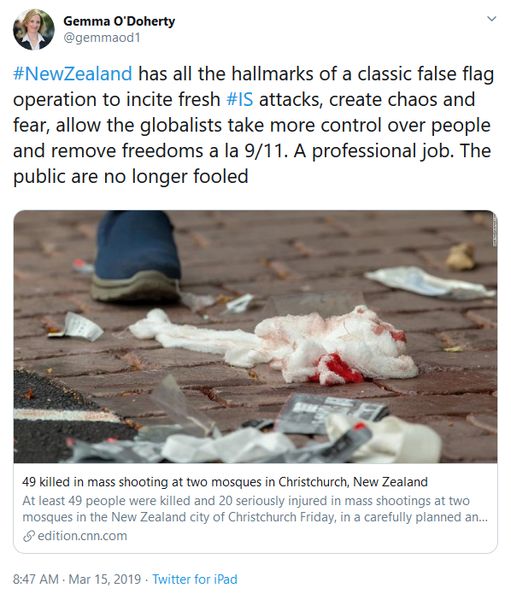
O’Doherty is currently an Independent by-election a candidate in the Dublin North constituency of Fingal. Voters there go to the polls on November 29th.
Rowan Croft (aka Grand Torino)
Rowan Croft is a former British soldier from Ballyboden, a suburb in south Dublin. Calling himself ‘Grand Torino’ many feel the popular Irish comedy figure ‘Sir Steve Timothy’ a shouting conspiracy theorist, is loosely based on Croft’s output.
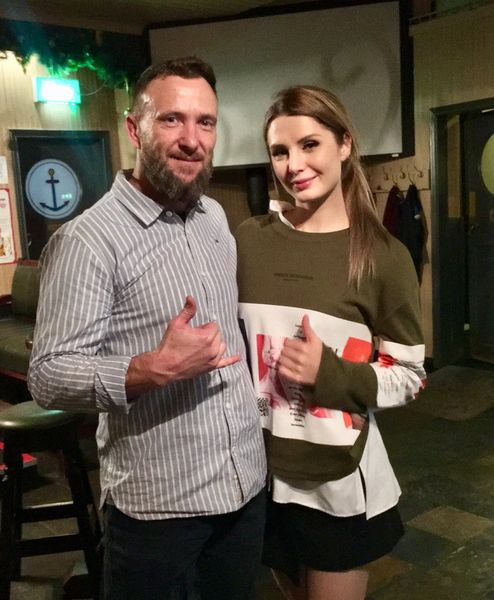
Now in his late forties, Croft claims he had his ‘eyes opened’ by American conspiracy theorist Alex Jones a few years ago. Described by former friends as a “grifter” many regard Croft as a Stephen Lennon (aka ‘Tommy Robinson’ founder of the English Defence League) figure, constantly asking for money to pursue his ridiculous pursuits of the “truth.” To this end, like far right identities in Britain during the European Elections, Croft was also ‘milkshaked’ while doing a live to air broadcast to his followers. His detractors also refer to him as a ‘Black & tan’ a hated irregular police force sent to Ireland by Winston Churchill to terrorise and murder Irish people during the Irish war of independence between 1919-1921.
Croft trades on his ex-British army history to present himself as ‘hardman’ and defender of the Irish, but it doesn’t take much watching of Croft’s videos to see he lacks great intellect. He interviews a mixture fundamentalist Catholics, white nationalist loyalists and main characters from micro far right parties to position himself as a their overarching leader and man of great intellect.
Croft has recently been booted out of his home and also a local martial arts club where he had tried to ingratiate himself.
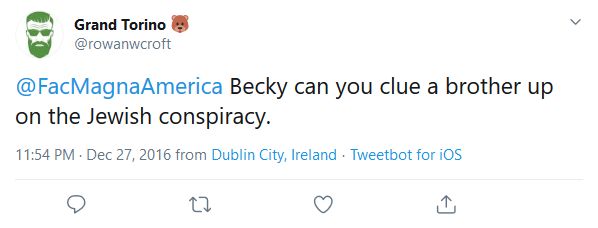
He recently told viewers of one of his videos to “fuck off” if they did not “bleed for Ireland.” He is often seen around the centre of Dubin trying to interview people that do not speak English. He is particularly keen to interview Muslims.
Croft is an ‘enabler’ of other fascists and consciously trying to network the disparate far right micro groupings in Ireland that historically haven’t worked with each other. To this end he has had little success, but he has now become a figure of both extreme ridicule and fear.

Right-wing comic Kearse saves the worst material for his anonymous Telegram account HOPE not hate has identified an anonymised Telegram account belonging to the GB…